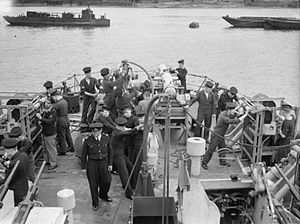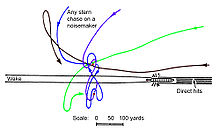
Sonar is a technique that uses sound propagation to navigate, measure distances (ranging), communicate with or detect objects on or under the surface of the water, such as other vessels.

A modern torpedo is an underwater ranged weapon launched above or below the water surface, self-propelled towards a target, and with an explosive warhead designed to detonate either on contact with or in proximity to the target. Historically, such a device was called an automotive, automobile, locomotive, or fish torpedo; colloquially a fish. The term torpedo originally applied to a variety of devices, most of which would today be called mines. From about 1900, torpedo has been used strictly to designate a self-propelled underwater explosive device.

U-boats were naval submarines operated by Germany, particularly in the First and Second World Wars. The term is an anglicised version of the German word U-Boot, a shortening of Unterseeboot, though the German term refers to any submarine. Austro-Hungarian Navy submarines were also known as U-boats.
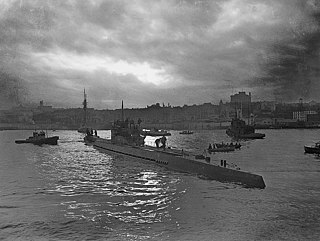
German submarine U-190 was a Type IXC/40 U-boat of Nazi Germany's Kriegsmarine built for service during World War II.

HMS Hesperus was an H-class destroyer that had originally been ordered by the Brazilian Navy with the name Juruena in the late 1930s, but was purchased by the Royal Navy after the beginning of World War II in September 1939, commissioned in 1940 as HMS Hearty and then quickly renamed as Hesperus.

An electronic countermeasure (ECM) is an electrical or electronic device designed to trick or deceive radar, sonar, or other detection systems, like infrared (IR) or lasers. It may be used both offensively and defensively to deny targeting information to an enemy. The system may make many separate targets appear to the enemy, or make the real target appear to disappear or move about randomly. It is used effectively to protect aircraft from guided missiles. Most air forces use ECM to protect their aircraft from attack. It has also been deployed by military ships and recently on some advanced tanks to fool laser/IR guided missiles. It is frequently coupled with stealth advances so that the ECM systems have an easier job. Offensive ECM often takes the form of jamming. Self-protecting (defensive) ECM includes using blip enhancement and jamming of missile terminal homers.
Acoustic homing is the process in which a system uses the sound or acoustic signals of a target or destination to guide a moving object. There are two types of acoustic homing: passive acoustic homing and active acoustic homing. Objects using passive acoustic homing rely on detecting acoustic emissions produced by the target. Conversely, objects using active acoustic homing make use of sonar to emit a signal and detect its reflection off the target. The signal detected is then processed by the system to determine the proper response for the object. Acoustic homing is useful for applications where other forms of navigation and tracking can be ineffective. It is commonly used in environments where radio or GPS signals can not be detected, such as underwater.

HMS Kite (U87) was a Modified Black Swan-class sloop of the Royal Navy, once commanded by the famous U-boat hunter Captain Frederic John Walker. She was one of several ships of that class that took part in the famous "six in one trip" in 1944.

The AN/SLQ-25 Nixie and its variants are towed torpedo decoys used on US and allied warships. It consists of a towed decoy device (TB-14A) and a shipboard signal generator. The Nixie is capable of defeating wake-homing, acousting-homing, and wire-guided torpedoes. The decoy emits signals to draw a torpedo away from its intended target.

Prairie-Masker is a radiated noise reduction system fitted to some western warships, including the Oliver Hazard Perry-class frigates, Spruance and Arleigh Burke-class destroyers, and the Ticonderoga-class cruisers of the US Navy. The system was also installed during the 1960s on a limited number of post WWII Guppy III modified, and later diesel submarines.
The G7e torpedo was the standard electric torpedo used by the German Kriegsmarine submarines in World War II. It came in 20 different versions, with the initial model G7e(TII) in service at the outbreak of the war. Due to several problems, leading to the German "Torpedokrise" which lasted until the end of 1941, the improved G7e(TIII) took over as the standard electric torpedo used by German U-boats for the rest of the war. G7e torpedoes measured 533.4 mm (21.00 in) in diameter and about 7.2 m (24 ft) in length. Depending on the type, the warhead contained a main charge of 250–280 kg (550–620 lb) of Schießwolle 36, a mixture of dipicrylamine and TNT. All were powered by 60–72 kW (80–100 hp) electric motors and lead-acid batteries which required onboard maintenance to maintain their functionality.

An acoustic torpedo is a torpedo that aims itself by listening for characteristic sounds of its target or by searching for it using sonar. Acoustic torpedoes are usually designed for medium-range use, and often fired from a submarine.
The G7es (T5) "Zaunkönig" ("wren") was a passive acoustic torpedo employed by German U-boats during World War II. It was called the GNAT by the British.

The Mark 24 mine is an air-dropped anti-submarine (ASW) acoustic torpedo developed by the United States during World War II; it was called a mine to conceal its capabilities. The torpedo entered service with the Allies in March 1943; the United States Navy (USN) used it until 1948. Approximately 4,000 were produced. Of the 340 deployed during the war, 204 were fired, sinking 37 and damaging 18 Axis submarines.

Anti-submarine warfare is a branch of underwater warfare that uses surface warships, aircraft, submarines, or other platforms, to find, track, and deter, damage, or destroy enemy submarines. Such operations are typically carried out to protect friendly shipping and coastal facilities from submarine attacks and to overcome blockades.

HMCS Alberni was a Flower-class corvette that served in the Royal Canadian Navy (RCN) during the Second World War. The Flower-class corvettes were warships designed for anti-submarine warfare. The ship was constructed by Yarrows Ltd. in Esquimalt, British Columbia, laid down on 19 April 1940, launched on 22 August and commissioned on 4 February 1941. The corvette sailed east to join the RCN's fleet in the Atlantic via the Panama Canal, where upon arrival, the vessel began escorting trans-atlantic convoys in the Battle of the Atlantic. Alberni took part in the key convoy battle of Convoy SC 42. In 1942, the corvette was transferred to Allied convoy assignments associated with Operation Torch in the Mediterranean Sea. In 1944, Alberni was among the Canadian naval vessels assigned to Operation Neptune, the naval component of the invasion of Normandy and escorted support ships to and from the United Kingdom on D-day.

The T-Mk 6 Fanfare is a towed sonar decoy developed after the Second World War by the United States Navy. It replaced the Foxer noisemaker. It was more effective than the Foxer, producing a sound similar to a ship's propeller, rather than wideband noise.
The term acoustic signature is used to describe a combination of acoustic emissions of sound emitters, such as those of ships and submarines. In addition, aircraft, machinery, and living animals can be described as having their own characteristic acoustic signatures or sound attributes, which can be used to study their condition, behavior, and physical location.
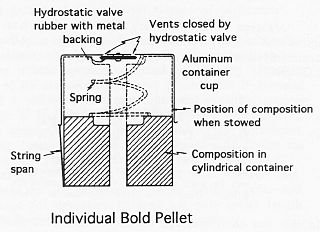
A sonar decoy is a device for decoying sonar. Most are released from submarines to act as a false target.
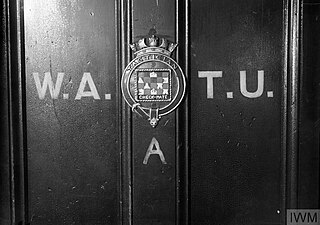
The Western Approaches Tactical Unit (WATU) was a unit of the British Royal Navy created in January 1942 to develop and disseminate new tactics to counter German submarine attacks on trans-Atlantic shipping convoys. It was led by Captain Gilbert Roberts and was principally staffed by officers and ratings from the Women's Royal Naval Service (Wrens). Their primary tool for studying U-boat attacks and developing countermeasures was wargames. After the U-boat threat to merchant shipping was defeated, WATU continued to develop anti-submarine tactics for later stages of the war, including Operation Overlord and the Pacific War. WATU trained naval officers in its tactics by hosting week-long training courses in which the students played wargames. WATU formally ceased operations at the end of July 1945.
